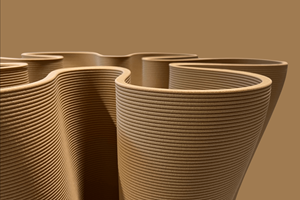Carbon-Kevlar hybrid redefines the hinge
Composite design outperforms comparable stainless steel at same price.
Talon Technology (Brookvale, Australia) develops carbon fiber-reinforced plastic (CFRP) parts for manufacturers of volume consumer products, including furniture and sporting goods, and does a bit of work for the aerospace industry. But its Carbon-Kevlar Hinge was an in-house project, inspired by parts seen in model aircraft, where CFRP panels were scored and cracked to form hinges. “This reminded us of the original hinges, made from fabric and leather,” recalls Talon CEO Geoff Germon. “Our idea was to develop a composite hinge without any metal, that would be super lightweight and also a solution for industries that can’t use metal.”
After two years of optimizing its performance and producibility, the final Carbon-Kevlar Hinge design has co-molded carbon fiber prepreg mounting plates — Talon calls them wings — with a gap between them in which the hinge’s flex unit is formed. The wings might be woven carbon fiber/epoxy laminate or a hybrid glass and carbon fiber/epoxy laminate, while the flex unit is woven Kevlar impregnated with polyurethane. The wings are available in multiple sizes and the flex unit can be ordered as single Kevlar or for heavy duty with a double Kevlar layer. Most Carbon-Kevlar Hinge products are supplied in lengths ranging from 12 mm to 1,000 mm. But Germon cites the case of a 2.1m long hinge made recently for a carbon fiber composite motorhome.
“Our lightest duty hinge has a closed thickness of 1.6 mm, which is probably the thinnest hinge in the world that also has reasonable strength,” says Germon. This hinge is, in fact, very strong, able to sustain a static load of 150 kg in a 50-mm long, 25-mm wide configuration. Germon asserts a similar metal hinge would hold roughly 50 kg. Although this thinnest hinge is designed for bonded assembly, thicker Carbon-Kevlar Hinge products can be bonded, attached with screws or both. “One of the issues with metal hinges is that you can’t bond them, especially stainless steel,” Germon notes. “Our composite hinges, however, are perfectly suited for adhesive bonding.”
The Carbon-Kevlar Hinge also is not limited to flat surfaces. “We can mold complex forms into the CFRP wings,” Germon explains. Talon Technology also can integrate multiple hinges into a CFRP part, using a one-shot process, that creates complex folding structures. “We have just produced a hinge with a wooden finish and are also producing a CFRP hinge with integrated fittings for electric cabling,” he adds.
Germon sees the Carbon-Kevlar Hinge as the first commercial application of carbon fiber that can be a stock item on a retail shelf next to metal products. The hinge will soon be listed in the popular McMaster-Carr industrial supply catalog and at the same price point as a high-quality stainless steel hinge, he adds, noting, “This is not being sold on the basis of it being carbon fiber, but instead, on its superior performance as a consumer item.” Germon believes that the composites industry has educated the market to think that carbon fiber is always expensive. “In our case, it’s not. We are re-educating the market to understand that it’s a matter of how the carbon composite part is designed and how you use the fiber.”
But the consumer isn’t the only target. Aircraft interiors suppliers have expressed interest, and a prestige auto manufacturer is planning to use the Carbon-Kevlar Hinge in an upcoming model’s seat application. “We are working to develop the necessary impact and shock-test data now,” says Germon. Noting that one of The Boeing Co.’s (Chicago, IL, US) Tier 1 interior suppliers has a 700,000-cycle test for hinges, Germon reveals, “We just put our hinges through one million cycles of this test, which uses very fast cycling through an 80° arc, roughly 340 cycles/minute, which is more than 5 cycles per second. That would normally kill most metal hinges, but ours,” he claims, “showed no change whatsoever.”
Germon emphasizes that hinge hardware is a multi-billion-dollar market. “We need to reach out and educate industrial designers and engineers about composites,” he argues.
Note: Talon Technology’s Carbon-Kevlar Hinge is one of five finalists for the 2017 CAMX award for Unsurpassed Innovation and will be on display in the awards area at the back of the Exhibit Hall.
Related Content
Combining multifunctional thermoplastic composites, additive manufacturing for next-gen airframe structures
The DOMMINIO project combines AFP with 3D printed gyroid cores, embedded SHM sensors and smart materials for induction-driven disassembly of parts at end of life.
Read MoreBladder-assisted compression molding derivative produces complex, autoclave-quality automotive parts
HP Composites’ AirPower technology enables high-rate CFRP roof production with 50% energy savings for the Maserati MC20.
Read MoreLow-cost, efficient CFRP anisogrid lattice structures
CIRA uses patented parallel winding, dry fiber, silicone tooling and resin infusion to cut labor for lightweight, heavily loaded space applications.
Read MoreSulapac introduces Sulapac Flow 1.7 to replace PLA, ABS and PP in FDM, FGF
Available as filament and granules for extrusion, new wood composite matches properties yet is compostable, eliminates microplastics and reduces carbon footprint.
Read MoreRead Next
Cutting 100 pounds, certification time for the X-59 nose cone
Swift Engineering used HyperX software to remove 100 pounds from 38-foot graphite/epoxy cored nose cone for X-59 supersonic aircraft.
Read MoreScaling up, optimizing the flax fiber composite camper
Greenlander’s Sherpa RV cab, which is largely constructed from flax fiber/bio-epoxy sandwich panels, nears commercial production readiness and next-generation scale-up.
Read MoreCeramic matrix composites: Faster, cheaper, higher temperature
New players proliferate, increasing CMC materials and manufacturing capacity, novel processes and automation to meet demand for higher part volumes and performance.
Read More











